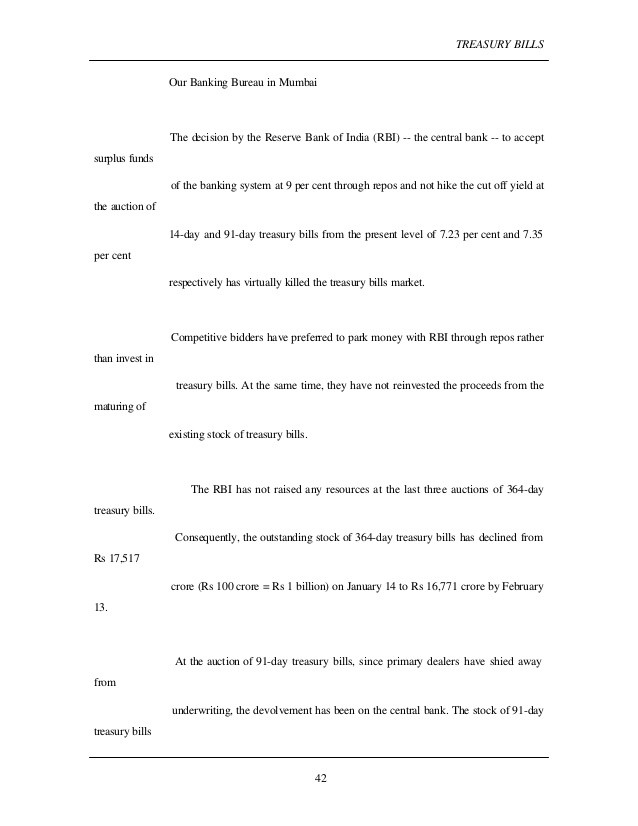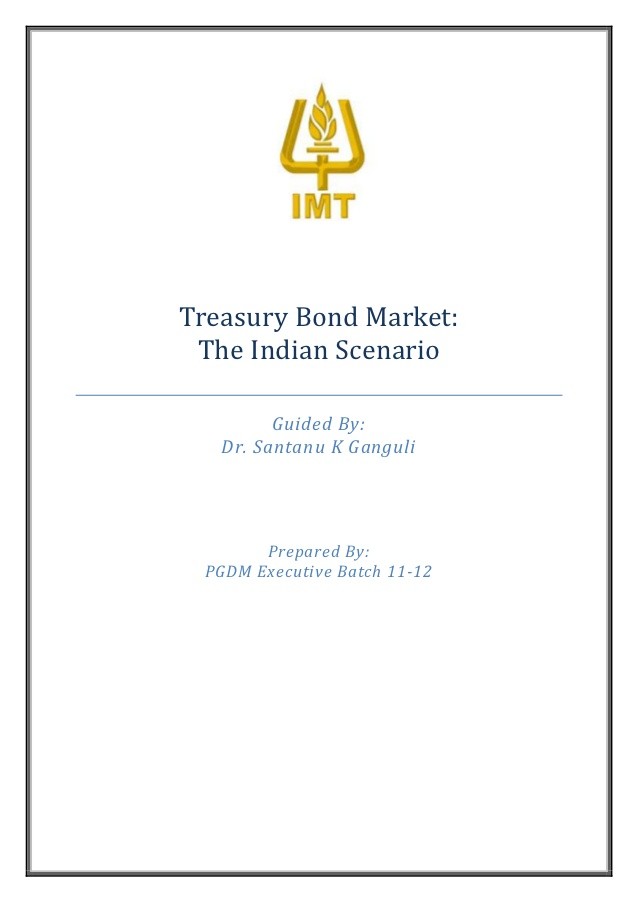Looking at the Treasury Bill Markets in India
Post on: 10 Август, 2015 No Comment

Treasury Bills are financial instruments used by Government of India for short term financing. They are generally issued at some discount to face value and are therefore also called discounted securities. When we subtract the issue price from the maturity value we get the return on investment.
Basically te treasury bills are classified on the basis of their maturity period like, ad-hoc Treasury bills, 3 months, 12months Treasury bills etc. In India, there used to be 14-days, 91-days, 182-days and 364-days Treasury bills but at present only 91-days and 364-days T-bills are traded in market. They are traded at both primary as well as secondary markets.
1.1 Benefits of investing in T-bills
No tax deducted at source
Zero default risk being sovereign paper
Highly liquid money market instrument
Better returns especially in the short term
Simplified settlement
High degree of tradeability and active secondary market facilitates meeting unplanned fund requirements.
Market related yields
Ideal matching for funds management particularly for short term tenors of less than 15 days.
Transparency in operations as the transactions would be put through Reserve Bank of India’s SGL or Client’s Gilt account only.
Two way quotes offered by primary dealers for purchase and sale of treasury bills.
Certainty in terms of availability, entry & exit.
When to switch away from T-bills
But treasury bills are not always the best investment option to park the surplus funds. A study done by Ruben Trevino and Barbara Yates in 2003 examines the question of when it might be advisable to switch from money market instruments (such as Treasury bills) to the typically higher yielding short-term bonds. Specifically, the study tests whether current yield levels and current yield spreads are useful in predicting subsequent differences in one-year returns between investing in five-year T-bonds and three-month T-bills.
Using the period of 1954 to 2003, the study finds that while the prior yield level is not consistently related to the relative performance of short-term T bonds compared with T-bills, the size of the prior yield spread does predict the odds of short-term T-bond returns outperforming T-bill returns.
When the spread is positive and greater than 200 basis points, there is a 70 percent chance that short-term T-bond returns will be higher than T-bill returns.

When the yield spread is negative (inverted yield curve), the odds are clearly in favour of T-bills; there is a 75 percent chance that T-bill returns will be higher than short-term T-bond returns. For spreads between 0 and 200 basis points, the odds are 50-50 that short term T-bonds or T-bills will provide higher returns.
The historical evidence also suggests that the reason spreads can predict relative performance between short term T-bonds and T-bills is because they anticipate, to some extent future changes in interest rates.
1.3 Portfolio Management Strategies
Strategies for managing a portfolio can broadly be classified as active or passive strategies.
Buy And Hold: A buy and hold strategy can be described as a passive strategy since the Treasury bills once purchased, would be held till its maturity. The salient features of this strategy are:
Return is fixed or locked in at the time of investment itself.
The exposure to price variations due to secondary market fluctuations is eliminated.
There is no risk of default on maturity.
Buy And Trade: This strategy can also be described as an active market strategy. The returns on this strategy are higher than the buy and hold strategy as the yield can be optimised by actively trading the treasury bills in the secondary market before maturity. This strategy involves altering the average duration of t-bills in a portfolio depending upon the portfolio manager’s expectations regarding the direction of interest rates. If T-bill yields are expected to fall, the portfolio manager would buy the T-bills with longer duration and sell T-bills with shorter duration, until the portfolio’s average duration becomes longer than the market’s average duration.














